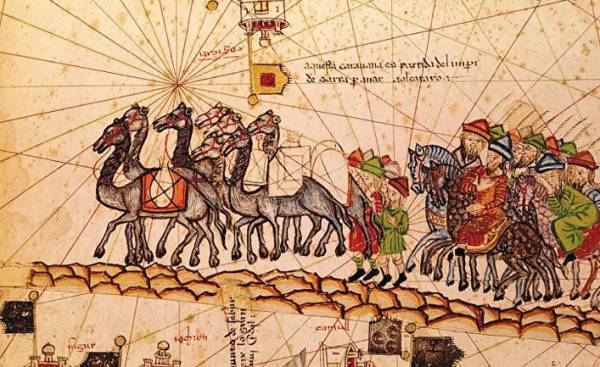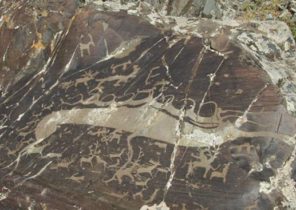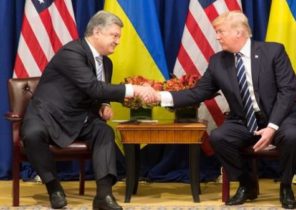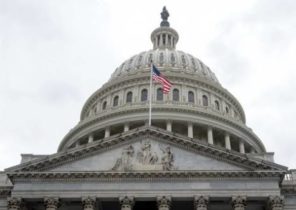
The idea of creating a new silk road sounded promising: to invest trillions of dollars in infrastructure projects in a barren desert, which is a large part of Central Asia, and trade begins to flourish, the economy to grow and peace will reign. However, most experts believe that problems in the real world will lead to the fact that this idea will remain a pipe dream.
This concept is called “One belt and one road”, it was put forward by Chinese leader XI Jinping in March 2015. It has two elements: one is the land route from China to Europe via Asia — the economic belt of the silk road and other sea route reaching from China to Europe through India and Africa, is called the Maritime silk Road.
Although the estimates are different, China is urged to make up $ 5 trillion in infrastructure investment over the next five years in 65 countries on these routes. Ports in Sri Lanka, the Railways in Thailand and roads and power plants in Pakistan — just a few examples of planned investments.
Speaking at a forum in Beijing in may this year, si said, “In the framework of the initiative “One belt and one road” we have to focus on the fundamental question of development, to develop the growth potential of different countries and to achieve economic integration, the interrelated development and the benefit of all.”
He speaks about the outcomes, but the details are extremely vague. The project aims to improve intergovernmental communication, to coordinate plans to develop soft infrastructure and strengthen tourism and trade, but the details are obscure.
“In terms of the Chinese government no specific actions have become one of the most significant policy initiatives, XI. The document contains a number of General proposals interspersed with platitudes about cooperation and mutual understanding”, — said in a July report from research firm Geopolitical Futures.
But despite the lack of specific programmes, huge sums show that silk road has received support in many countries. The Asian Bank for infrastructure and investment has pledged 269 billion dollars for the project. Even the Prime Minister of Japan Shinzo Abe expressed support at a recent G20 meeting in Hamburg, Germany.
Goals do not match reality
The purpose of China, explicit and implicit, must be weighed against the reality. Based on this, most experts believe the project is economically feasible. But it will enable China to gain political influence.
“All of this inflated. The numbers that they published, 4 to 5 trillion dollars, it’s totally unrealistic,” said Christopher balding, an Economics Professor at Peking University.
Economically, it mainly concerns investment and exports. “China has excess capital and excess production capacity, which motivated this set of initiatives. Given the high savings rate in China and a slowdown in industrial investments, they are looking for foreign projects that can be funded, and a new outlet for Chinese exports,” says James Nolt, Professor of international relations at new York University.
The result was this project, in which China will unite with the countries along the routes, to raise money to create the infrastructure necessary to facilitate trade. And build it to a Chinese company.
The holding company of China Overseas Ports expanded port of Gwadar in Pakistan, and had rented it to 2059. This is just the first small step to connect the economic zone of the silk road Maritime Silk road. For China-Pakistan economic corridor planned roads, pipelines, power plants, optical connections, and Railways with a total investment of 62 billion dollars.
Of course, local and international companies are going to bid on these projects, but if China will provide most of the funds, the majority of contracts will receive Chinese state-owned enterprises.
It is impossible to Finance
Then there is the issue of funding these investments. The country, which will be held investments, such as Pakistan and Cambodia, are not so rich to spend trillions. This is forcing China to come up with a way to get financing in hard currency to achieve their economic goals.
When the project was launched, China had nearly $ 4 trillion foreign exchange reserves, and he wanted them to invest. In 2017, the reserves fell to $ 3 trillion, it is the threshold, which allowed to understand the Central planners in Beijing, they will not cross.
“They have to use international bond markets or to exhaust their foreign exchange reserves and then borrow. Even by global standards of market bonds and program bonds to $ 5 trillion within a few years is a huge deal. They are not going to take the risk of repayment and are not going to Deplete their reserves,” said balding.
A study conducted by investment Bank Natixis, showed that such borrowing will increase the external debt of China from 12% to 50% of GDP. This will put exchange exchange rate risks and will put it in the same vulnerable position, what were the “Four Asian tiger” (South Korea, Singapore, Hong Kong and Taiwan) during the financial crisis of 1998.
Loans from China in RMB are not a good option for two reasons. It “creates a risk for over-stretched balance sheets of Chinese banks. In fact, their doubtful loans increased in the last few years, further complicating the lending”, especially for risky projects, wrote chief economist at Natixis Asia-Pacific region Alicia Garcia-Herrero in his blog.
In addition, the recipient countries could repay the loan just in yuan through the sale of goods and services to China, thus buying the Chinese currency. It was counterproductive for the promotion of exports from China and, ultimately, to the trading infrastructure.
“As Pakistan will repay the loan in RMB? They are going to create a positive balance of trade in yuan. Thus, China has to face a trade deficit in all countries to which it provides loans. Pakistan will have to form a certain trade surplus with another country to have sufficient capital to pay for China,” said balding.
Given that much of the infrastructure will be built to facilitate trade with China, this is unlikely. Thus, in the end, China will Finance the supplier of these projects. The only way for China to achieve its economic goals is loans in hard currency, which was fully repaid and make a profit, but China currently has no means.
Bad risks
All economic indicators the most known projects of the silk road point to the scenario of repayment.
There are many reasons why countries such as Cambodia, Laos, Thailand, Pakistan and Mongolia, there is no good infrastructure. They have generally poor macroeconomic frameworks, weak institutions, and high degree of corruption. Construction of roads and Railways won’t change that.
In addition, “Central Asia, a patchwork of States whose boundaries were drawn in such a way to facilitate management from Moscow in Soviet times, is hardly a promising market for Chinese goods,” the report says Geopolitical Futures.
“People say that China gives money. In almost every case, Chinese lending company provides the loan of a despotic dictator, for example, in Sri Lanka or Venezuela. None of it ended well,” said balding.
Economically stable countries, such as Malaysia and Vietnam, require lower investment than dysfunctional States such as the Kyrgyz Republic and Ukraine, torn by civil war. According to the rating Oxford Economics, these countries have the economic stability rating of 44 and 38.2, respectively, as compared with 66.8 in Malaysia.
“In those cases, when the financial development of countries is relatively weak, and governments have the most debt, financing will be crucial,” the report says Oxford Economics. These countries have the lowest chance of repayment.
“While the new airport or the railway can be built in just a few years, the accumulation of human and institutional capital necessary for efficient operation, and promote economic and social progress is a slow process,” the report says research firm TS Lombard.
Low coverage
Given the limitation in viable economic projects and funding, the scope of the project “One belt, one road” is likely to be small, while China is still able to focus on their political agenda to have a greater effect on the participating countries.
“What remains is a much smaller program from 15 to 30 billion dollars a year,’ said balding. Is commensurate with 269 billions of dollars have been promised by Chinese banks. I don’t want to say that it doesn’t matter, but it’s not a big deal. The United States spends $ 300 billion on direct investment abroad.”
One of the initiatives that makes sense but needs some infrastructure and investments, is the protection of ships from pirates. “The cooperation with Singapore to ensure the security of Maritime routes is promising, and this should be implemented anyway,” said Nolt.
Thanks to advances in shipping technology is much easier and cheaper to transport goods on ships and not by land. That’s why most of China and world trade (80%) is transported by sea.
In the end, protection from pirates and the construction of several ports in Pakistan and East Africa — it’s a worthwhile task, but it is far from construction of infrastructure, which has no outlet to the sea, in the trillions.
“The silk road was a constantly developing market that has moved goods across the continent, where they can be exchanged for other goods. And unlike today, Eurasia has been the center of world civilization, home to the most important economies,” the report says Geopolitical Futures.
Today, the most important economy, and China also is United States, and can best be achieved by sea across the Pacific ocean, far from the Maritime silk road and economic belt silk road.
Projects of Chinese infrastructure in Asia
The Chinese company, China Overseas Ports Holding analyzes the port of Gwadar in Pakistan until 2059 and has already started to expand it. China seeks to secure Maritime trade routes along the so-called Maritime silk road, the Pakistani port is a crucial element of infrastructure.
Thailand is a total of 69.5 billion dollars to Finance construction of high-speed rail and other major megatransaction, and most of the money comes from China and Chinese companies for the construction. Railway of Thailand will become part of the railway system to Kunming-Singapore. However, Thailand will repay the loans by exporting rice and rubber, thus using a positive trade balance with China.
The project “Mason-Ladies” in Burma worth $ 3.6 billion, although it is not officially part of the initiative “One belt and one road”, but this is an example of Chinese infrastructure project in a very poor country, which did not go as planned. Construction was suspended for six years because both countries were unable to agree on how to act.







